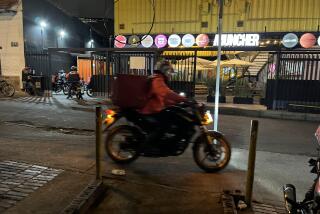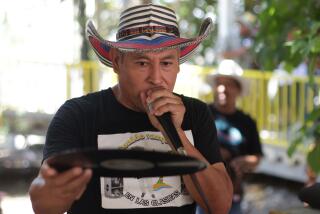Barranquilla a Backwater? Not so Fast, Rolling Stone
- Share via
I started reading the recent Rolling Stone cover story on Shakira but couldn’t get past the crude stereotype in the first paragraph. The writer correctly identifies the Colombian singer’s hometown as Barranquilla, but then promptly labels it a “backwater.”
I’m not Colombian and I’ve never been to Barranquilla, but I knew such a derogatory characterization couldn’t be right. There’s too much great music coming out of this ancient port city to dismiss it in passing as a stagnant or backward place.
Reporters should always start with their homework, so here’s a little history/geography lesson. Barranquilla was founded almost 400 years ago, in 1629, and is now the capital of the province (or departamento) named Atlantico. It happens to be Colombia’s fourth-largest city, with more than 1 million residents, and its largest port on the Caribbean Sea.
The city isn’t actually on the coast, but rather 15 miles upstream from the mouth of the Magdalena River, the waterway that served as the setting for “Love in the Time of Cholera,” the 1988 novel by acclaimed Colombian author Gabriel Garcia Marquez.
Barranquilla can claim the Nobel laureate as a native son. Gabo, as the novelist is affectionately known, moved there with his family when he was 8. He left home by steamboat at age 13, but always felt the pull of the coastal culture, vibrant and passionate compared with the cold formality of Bogota, the capital in the central highlands.
The Colombians I spoke to nearly gagged when they heard “Barranquilla” and “backwater” in the same sentence. They know the city as Colombia’s “Puerta de Oro,” the Gateway of Gold, because it’s awash in goods--and cultural currents--from around the world.
“It’s a city where music first arrives from many places,” says Barranquilla native Jose Garces, now a Miami-based concert promoter who brings Colombia’s top acts to the United States. “You hear salsa, cumbia, vallenato. You get music from Haiti and from Africa. And next to Brazil, the best carnival is in Barranquilla.”
The city’s most important modern musical export is Andres Cabas, a brilliant young singer-songwriter whose recent debut CD stands as one of the best Latin albums of the year so far. It’s an introduction befitting his cosmopolitan hometown: a vibrant fusion of snarling rock guitars with lilting tropical melodies and rich, folkloric rhythms.
For veteran Joe Arroyo, the respected salsa singer and bandleader, Barranquilla served as a hothouse for his fresh and exotic rhythms, absorbing all those beats and pulses from other places. Although born in nearby Cartagena, the former lead singer for Fruko y sus Tesos started his solo career in Barranquilla a quarter century ago. Arroyo developed his brand of salsa with original rhythms, including the narcissistically named Joeson.
Although lesser-known than, say, Oscar D’Leon, another salsero from neighboring Venezuela, Arroyo has been quite influential. Even Juanes, Colombia’s acclaimed singer-songwriter known for his rock roots, included one of Arroyo’s Caribbean classics on his latest pop album. Juanes closes his new work with the celebratory “La Noche” (The Night), which first appeared on Arroyo’s 1988 album, “Fuego en mi Mente” (Fire in my Mind).
That album also includes Arroyo’s fiery salsa ode to his adopted hometown, “En Barranquilla Me Quedo” (I’ll Stay in Barranquilla). The exciting song still prompts L.A. salseros to swarm the dance floor as Arroyo showers praise on the “enchanting” city, its “warm, welcoming people” and their “grand society.”
That ain’t just boosterism, says Rodrigo Obregon, a proud native of Barranquilla who’s now pursuing an acting career in Los Angeles. He says his hometown is everything the song says it is, and more.
“Barranquilla has always been an oasis of peace in Colombia,” says Obregon, who recently played a Colombian CIA operative in the Arnold Schwarzenegger film “Collateral Damage” “It’s a very civil place where all social classes get along under the harmony of a single, common culture.”
Nobody gets more enthusiastic or waxes more spontaneously poetic about the place than Obregon, whose pioneering family built the nation’s first textile plant and first tourist hotel, the El Prado. His mother, Sonia Osorio, is the director of the Ballet de Colombia in Bogota. His father, the late Alejandro Obregon, was a renowned painter and founder of La Cueva, a group of bohemian writers, intellectuals and adventurers who gathered at a Barranquilla bar of the same name to discuss Faulkner and Steinbeck.
Obregon says he feels pity for those--including journalists who should know better--whose ignorance prevents them from exploring beyond the stereotypes of “banana republics” and “Third World backwaters.”
But you can’t really blame them too much. The World Book Encyclopedia has no mention of Barranquilla. And even my own newspaper mostly mentions the city in a negative context: Of the 97 Times stories that have cited the city since 1985, the vast majority were about drugs, crime, guerrilla war or corruption.
The Internet tells you more about Barranquilla as the site of Colombia’s first telephone and its first plane flight. The city’s wharf, once the longest in the world, was an engineering marvel in its day, providing harbor to a stunning array of ships and people from all over the world.
“It’s like the Staten Island of Colombia,” says Obregon, a member of the L.A.-based civic group Unidos Por Colombia. “Progress itself entered through Barranquilla.”
*
Agustin Gurza is a Times staff writer.
More to Read
The biggest entertainment stories
Get our big stories about Hollywood, film, television, music, arts, culture and more right in your inbox as soon as they publish.
You may occasionally receive promotional content from the Los Angeles Times.










